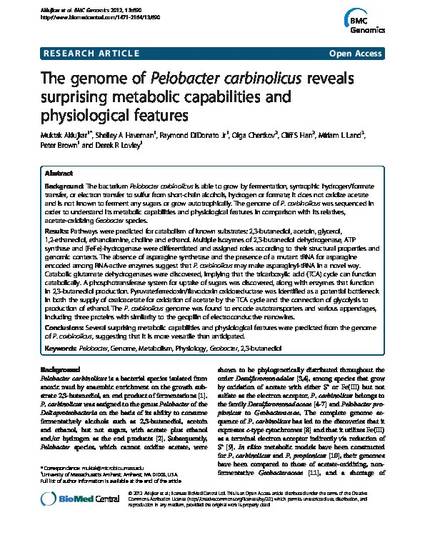
Background: The bacterium Pelobacter carbinolicus is able to grow by fermentation, syntrophic hydrogen/formate transfer, or electron transfer to sulfur from short-chain alcohols, hydrogen or formate; it does not oxidize acetate and is not known to ferment any sugars or grow autotrophically. The genome of P. carbinolicus was sequenced in order to understand its metabolic capabilities and physiological features in comparison with its relatives, acetate-oxidizing Geobacter species.
Results: Pathways were predicted for catabolism of known substrates: 2,3-butanediol, acetoin, glycerol, 1,2-ethanediol, ethanolamine, choline and ethanol. Multiple isozymes of 2,3-butanediol dehydrogenase, ATP synthase and [FeFe]-hydrogenase were differentiated and assigned roles according to their structural properties and genomic contexts. The absence of asparagine synthetase and the presence of a mutant tRNA for asparagine encoded among RNA-active enzymes suggest that P. carbinolicus may make asparaginyl-tRNA in a novel way. Catabolic glutamate dehydrogenases were discovered, implying that the tricarboxylic acid (TCA) cycle can function catabolically. A phosphotransferase system for uptake of sugars was discovered, along with enzymes that function in 2,3-butanediol production. Pyruvate:ferredoxin/flavodoxin oxidoreductase was identified as a potential bottleneck in both the supply of oxaloacetate for oxidation of acetate by the TCA cycle and the connection of glycolysis to production of ethanol. The P. carbinolicus genome was found to encode autotransporters and various appendages, including three proteins with similarity to the geopilin of electroconductive nanowires.
Conclusions: Several surprising metabolic capabilities and physiological features were predicted from the genome of P. carbinolicus, suggesting that it is more versatile than anticipated.
- Pelobacter,
- Genome,
- Metabolism,
- Physiology,
- Geobacter,
- 2,
- 3-butanediol
Available at: http://works.bepress.com/muktak_aklujkar/6/